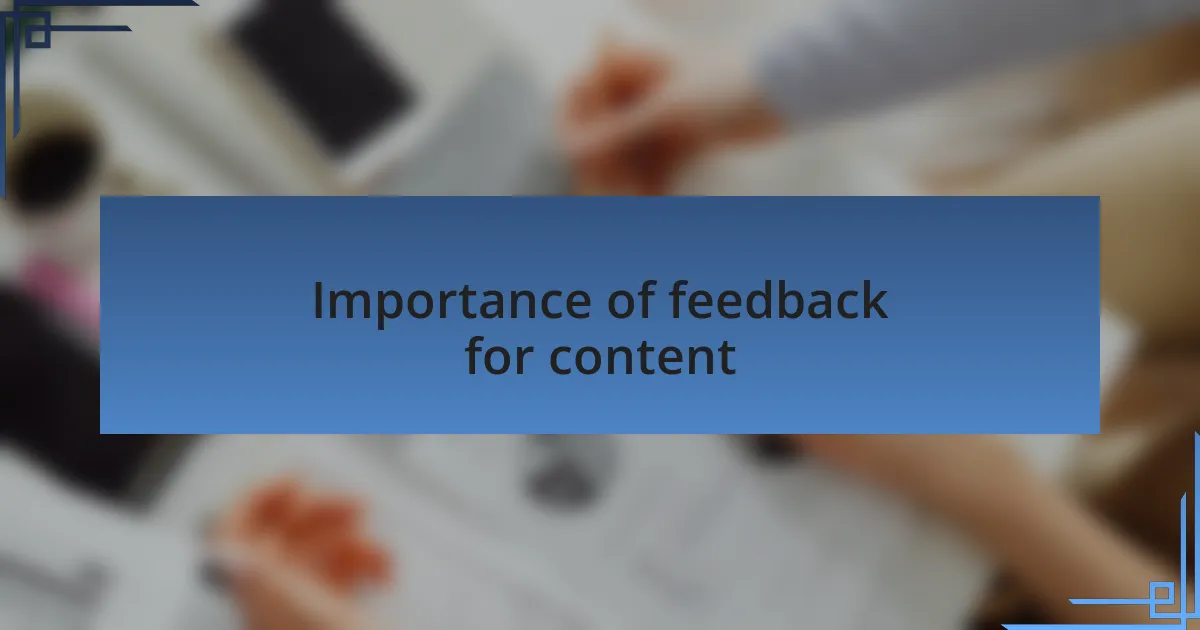Key takeaways:
- Feedback acts as a crucial guide in marketing, revealing gaps in audience understanding and fostering deeper client relationships through active listening.
- Both qualitative and quantitative feedback are essential; the former provides emotional insights while the latter offers measurable data, enhancing content effectiveness.
- Collecting feedback through various methods, such as regular check-ins, tailored forms, and workshops, can lead to valuable insights and collaborative improvements.
- Implementing changes based on feedback can lead to significant positive outcomes, such as improved user experience and stronger audience engagement.

Understanding feedback in marketing
Feedback in marketing is like a compass guiding you through the vast landscape of customer preferences and behaviors. I’ve often found that the insights gathered from client ratings and comments can lead to unexpected revelations. Have you ever experienced that moment when a piece of feedback reshapes your entire outlook on a campaign? It’s enlightening.
Take a moment to consider how feedback can reveal gaps in your understanding of your audience. I remember an instance when I received a response from a client that highlighted an overlooked demographic in my strategies. The realization was a bit jarring but ultimately empowering—it transformed my approach and led to more targeted and effective campaigns.
In essence, feedback is not just criticism; it’s an invaluable resource for growth. I believe that treating feedback as a conversation rather than a confrontation allows for deeper connections with clients. How can we harness this dialogue to create more meaningful interactions? By actively listening and adapting our strategies based on what our audience is telling us, we cultivate not only better content but also stronger relationships.

Importance of feedback for content
Gathering feedback for content is crucial because it provides a mirror reflecting how our audience perceives our efforts. I distinctly recall a campaign where the initial response was lukewarm; a small group of users pointed out that the messaging felt disconnected. That constructive criticism opened my eyes to the need for a clearer narrative, and I adjusted the content accordingly. Isn’t it fascinating how a few words can drive significant change?
Moreover, feedback acts as a reality check, ensuring that we stay aligned with our audience’s needs and expectations. I’ve faced moments where my creative instincts led me to produce content I adored, only to find that it didn’t resonate with the target audience. Each time, I learned to value feedback not just for what it says, but for what it teaches about the evolving landscape of digital marketing.
Finally, incorporating feedback fosters a sense of community and trust. When clients feel heard, their engagement deepens, and I’ve seen that ripple effect in increased loyalty and advocacy for the brand. Have you ever noticed how responding to feedback can spark a richer conversation? It’s a reminder that we’re all in this together, striving toward a shared vision.

Types of feedback for content
When considering the types of feedback for content, I find it essential to differentiate between qualitative and quantitative feedback. Quantitative feedback offers numeric data, such as clicks, shares, and engagement metrics. For instance, after launching a blog post, I often look at the analytics to see how many people interacted with it. Did it resonate? Numbers can tell a compelling story, but they don’t always capture the nuances of the audience’s feelings.
On the other hand, qualitative feedback gives depth to those numbers. I remember a time when a reader took the time to leave a thoughtful comment on one of my articles, sharing their personal experience and how it related to the topic at hand. That kind of insight is priceless; it offers a glimpse into the reader’s perspective and can highlight areas for improvement that data alone might miss. Isn’t it amazing how individuals can share stories that lead to broader understanding?
Finally, there’s informal feedback, which I gather through conversations in everyday interactions. I often chat with clients and colleagues about their favorite pieces or the content they found lacking. These discussions can unearth valuable insights and feelings that formal surveys may not capture. Have you ever noticed how casual chats can spark the most profound ideas? Through casual engagement, I gain a treasure trove of feedback that helps me craft content that feels alive and relevant.

Collecting feedback from clients
Collecting feedback from clients is one of the most enlightening aspects of my work as a digital marketer. I often schedule regular check-ins after project milestones to ask clients what they think about the content we’ve produced. During one session, a client vividly expressed how a particular campaign had exceeded their expectations, detailing not just the metrics but the feelings tied to their brand’s growth. Hearing that kind of enthusiasm not only validates my work but also motivates me to push boundaries even further.
Another effective method I use is feedback forms tailored to specific projects. These forms encourage clients to express their thoughts on various aspects of our content, from tone to relevance. I remember one time when a client pointed out that a blog post felt too technical for their audience. Their candid feedback prompted me to revamp my approach, ultimately leading to a piece that forged a stronger connection with the intended readers. It’s moments like that which remind me how critical it is to listen closely to our clients.
Additionally, I’ve found that hosting feedback workshops can be incredibly fruitful. In a recent workshop, I facilitated discussions among different clients to explore their perceptions of our content strategies. The collaborative atmosphere sparked fresh ideas and unexpected insights. Have you ever seen how groupthink can reveal blind spots in our content? These sessions not only enrich our content but also foster a deeper relationship with clients, making them feel truly involved in the creative process.

Analyzing feedback for improvements
Analyzing feedback transforms raw data into actionable insights. I remember sifting through a client survey and noticing a consistent theme: several readers found our call-to-action lacking in clarity. It dawned on me that what felt intuitive to me might not resonate with everyone. So, after some careful analysis, I rephrased the CTAs, making them more direct and user-friendly. The results were immediate; engagement soared. Don’t you agree that sometimes the simplest changes can yield the greatest impact?
When I dive into qualitative feedback, I often discover nuances that quantitative data might overlook. A few months back, one client shared a heartfelt concern about how our content was missing the emotional connection with their audience. Analyzing this feedback, I realized that I had been so focused on delivering facts that I neglected storytelling. By weaving more personal narratives into our content strategy, I saw improved audience retention and deeper engagement. Isn’t it fascinating how a small shift in approach can breathe life into our content?
I also find it invaluable to look for feedback patterns over time. One time, I noticed multiple clients mentioning that our content felt a bit dated. This repetitive cue definitely caught my attention. After conducting a thorough review, I recognized the need for a more agile content update plan that reflects industry trends. By proactively adapting to evolving client expectations, we not only enhance our credibility but also align more closely with their needs. Isn’t ongoing improvement what keeps us relevant in this fast-paced digital world?

Implementing changes based on feedback
Implementing feedback isn’t just about making tweaks; it’s a mindset shift. I recall a time when a client voiced frustration about our website’s navigation. They felt lost trying to find key resources, so I took that to heart. After brainstorming and testing a few layout adjustments, we revamped the site’s navigation to be more intuitive, leading to a noticeable drop in bounce rates. Isn’t it rewarding to see how aligning with users’ experiences can transform their journey?
I’ve found that when I act quickly on feedback, the impact is often greater. Once, I received a suggestion about our blog’s tone. A reader mentioned that it lacked warmth and approachability. I took that seriously and revamped several posts to reflect a more conversational, friendly tone. The response was overwhelmingly positive, with readers commenting on how welcomed they felt. Isn’t it amazing how modifying your voice can foster community?
Sometimes, it’s the cumulative effect of multiple feedback points that drives change. I remember receiving various comments about the frequency of our content updates. Rather than dismiss these concerns, I decided to implement a content calendar that included more regular posts. Not only did this let us stay current, but it also gave our audience something to anticipate consistently. Isn’t that what we all want — to belong to a vibrant, active community that values our input?